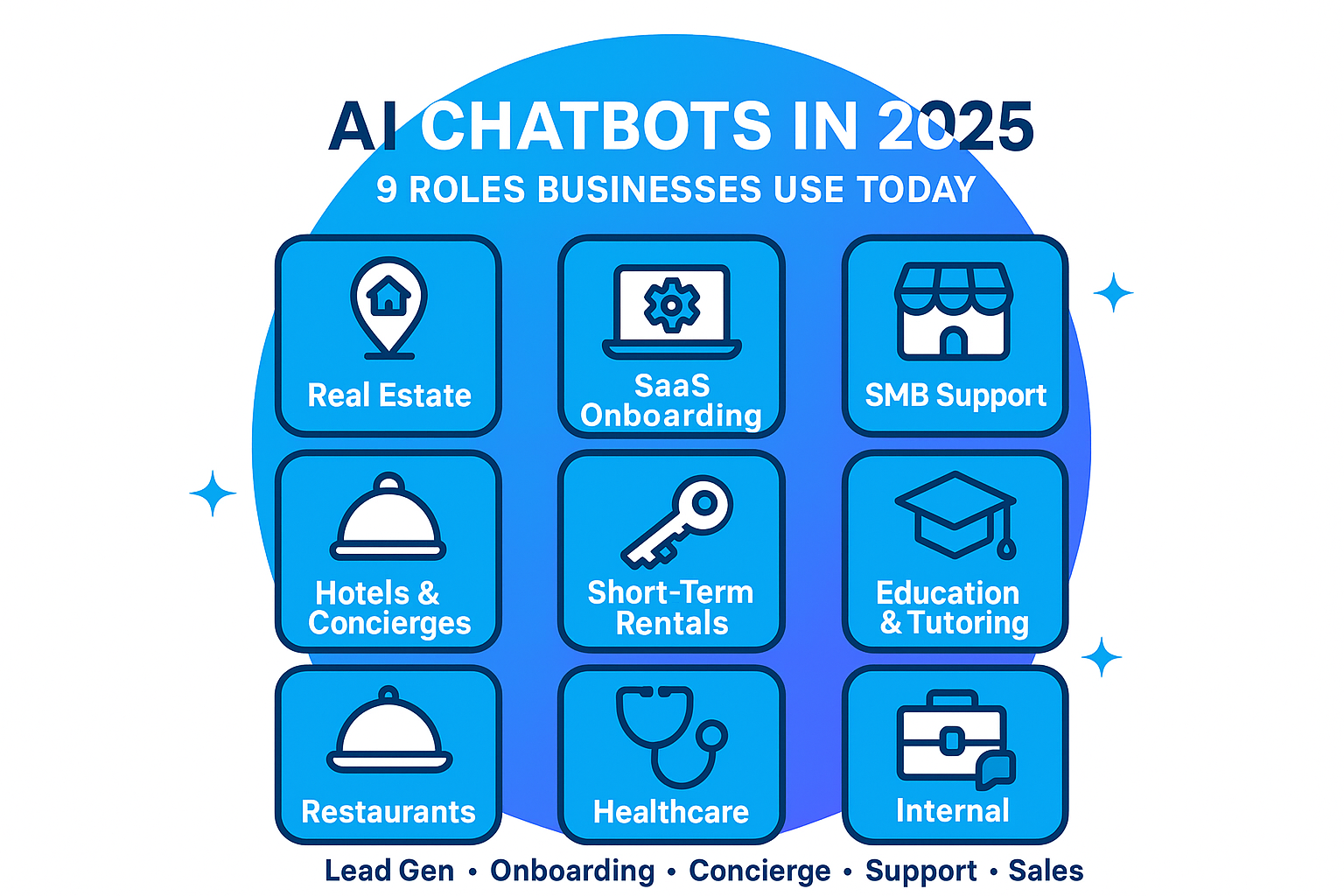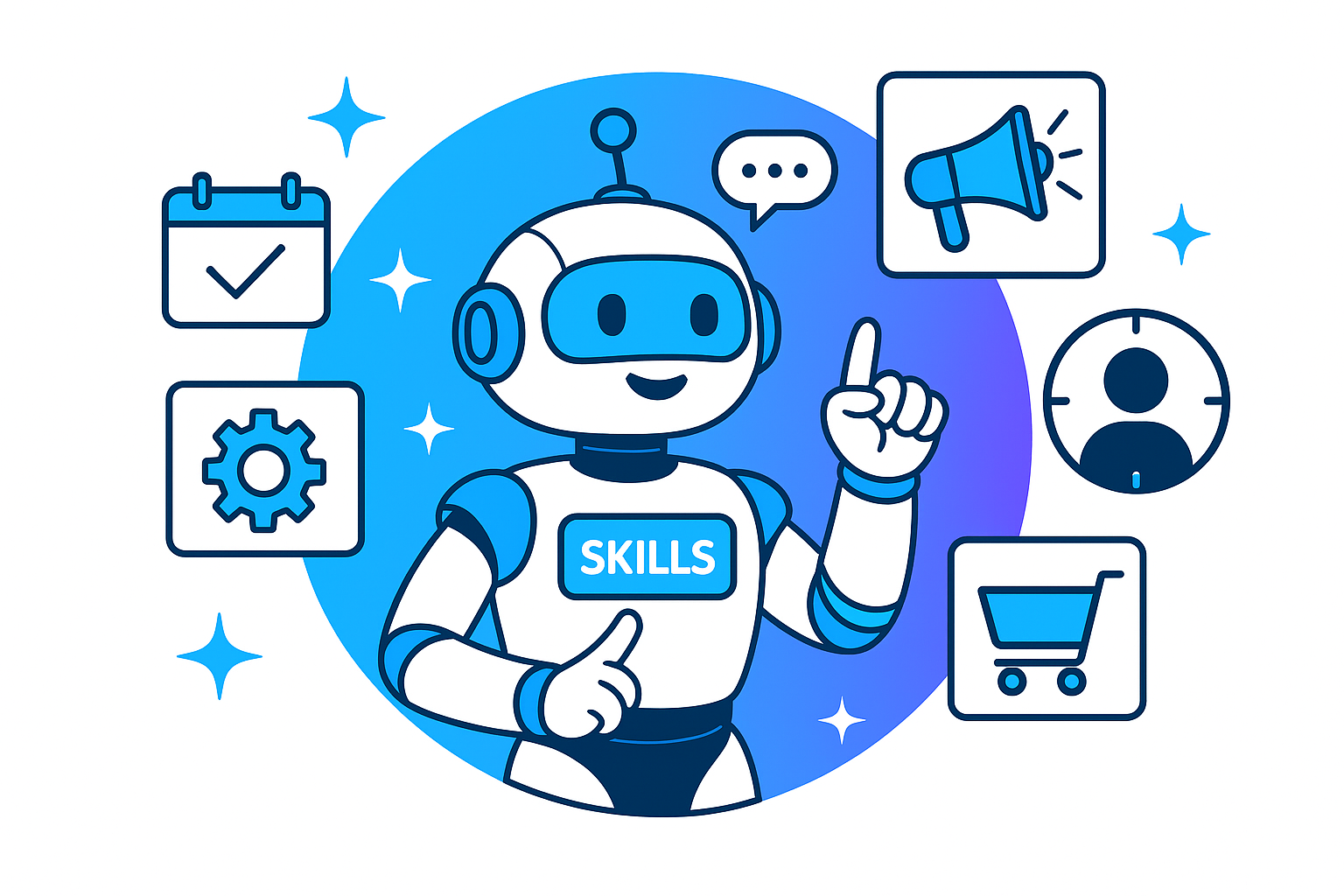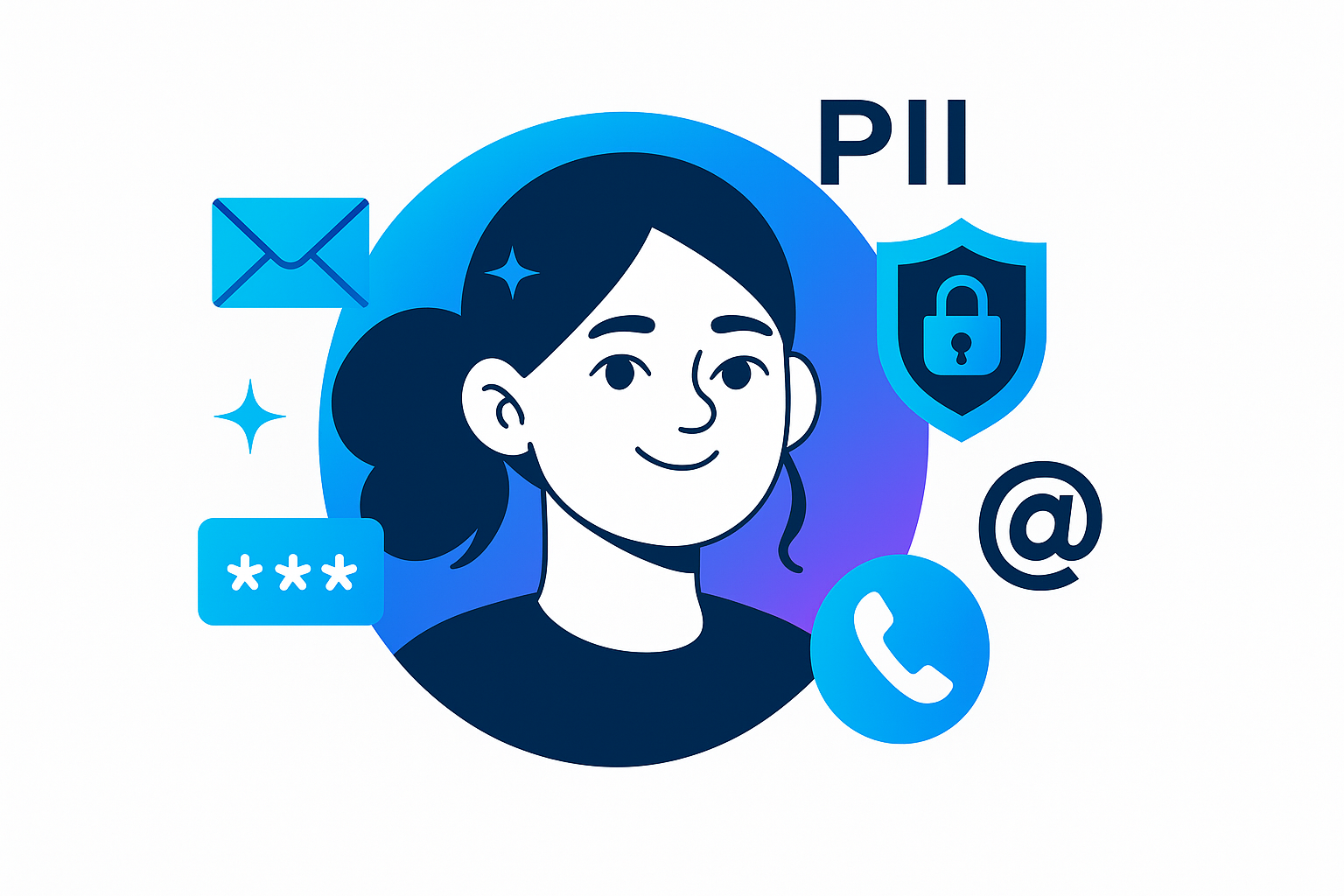Meet the 2025 chatbots that actually helps

AI chatbots have evolved far beyond answering FAQs. In 2025, they're acting as virtual assistants, lead generators, onboarding coaches, internal knowledge hubs, and revenue drivers—all while working 24/7.
For small and medium-sized businesses (SMBs) and industry-specific operators, the question isn't "Should we use a chatbot?" it's "How can we deploy one to create the biggest impact?"
Here are nine domains where AI chatbots are delivering real value, with concrete use cases for each.
1. Real Estate – Turning Lookers into Viewers
How they help:
In real estate, fast follow-up is everything. Chatbots can instantly capture buyer intent and guide prospects toward viewings without waiting for an agent to call back.
Use cases:
- Instant lead qualification – Ask a few smart questions about budget, location, and move-in date.
- Property recommendations – Match answers to current listings in seconds.
- Multimedia showcase – Share photos, 360° tours, and videos right in chat.
- Viewing scheduling – Let users book directly into an agent's calendar.
Example:
User: "I'm looking for a 3-bedroom condo near the city for under $1M."
Chatbot: "I've found 4 condos that match your criteria. Here's one in Marina Bay with a 360° tour. Would you like to book a viewing this Saturday at 2 PM?"
Impact: Agencies see up to 50% faster lead responses and higher viewing attendance rates.
2. SaaS – Helping Users Get Started and Stay Happy
How they help:
For SaaS companies, user onboarding and engagement can make or break retention. Chatbots guide new users, resolve issues, and highlight features they might not know about.
Use cases:
- Guided product tours – Walk new users through account setup step-by-step.
- Contextual help – Offer relevant support based on what's on screen.
- Feature discovery – Suggest relevant tools or integrations.
- Technical assistance – Answer API questions and provide code snippets.
Example:
User: "How do I connect my Google Drive?"
Chatbot: "Here's a step-by-step guide with screenshots. Would you like me to set up the integration for you now?"
Impact: SaaS products using chatbot-assisted onboarding often see 20–30% more active users.
3. SMBs – Big Service Without a Big Budget
How they help:
Small businesses can now deliver enterprise-level service without hiring extra staff. Chatbots handle the repetitive work so owners can focus on operations.
Use cases:
- Automated FAQs – Prices, services, opening hours.
- Lead capture – Collect names, contact info, and service needs.
- Omnichannel availability – Be present on WhatsApp, Instagram, and Messenger.
- Post-sale follow-up – Send thank-yous, request reviews, and offer loyalty rewards.
Example:
User: "Do you do weekend appointments?"
Chatbot: "Yes! We have a 10 AM slot this Saturday. Shall I book it for you?"
Impact: SMBs report fewer missed leads and higher repeat customer rates.
4. Hospitality & Hotels – Your Always-Ready Concierge
How they help:
Hotels can use chatbots as a digital concierge, handling guest needs before, during, and after their stay.
Use cases:
- Instant booking confirmation – Check availability and take reservations.
- Guest inquiries – Answer questions about amenities, dining, and attractions.
- Upselling – Promote spa packages, tours, and dining offers.
- Pre-arrival personalization – Collect pillow, dietary, or room preferences.
Example:
User: "Do you have spa appointments tomorrow evening?"
Chatbot: "Yes! I can book you for 7 PM with our signature massage. Would you like me to add it to your room charge?"
Impact: Increased ancillary sales and better guest satisfaction scores.
5. Short-Term Rentals – Smooth Stays, Great Reviews
How they help:
For Airbnb-style hosts, chatbots keep communication instant and consistent—critical for good reviews.
Use cases:
- Pre-booking Q&A – House rules, location info, amenities.
- Self-check-in instructions – Door codes, parking details, Wi-Fi passwords.
- Maintenance alerts – Report issues directly to service providers.
- Review follow-up – Thank guests and request reviews post-stay.
Example:
User: "Is there parking at the property?"
Chatbot: "Yes, there's a private space right next to the entrance. Here's a photo and map for when you arrive."
Impact: Hosts cut 70% of manual messaging and boost ratings.
6. Education – From Signing Up to Getting Taught
How they help:
Schools and learning platforms can use chatbots to assist students, reduce admin work, and support learning.
Use cases:
- Admissions help – Application guidance and deadline reminders.
- Course matching – Recommend classes based on career goals.
- AI tutoring – Explain concepts, run quizzes, and provide study tips.
- Progress tracking – Remind students about assignments and exams.
Example:
User: "I'm interested in data science courses."
Chatbot: "We have two starting next month. Here's the syllabus and a free intro lesson video."
Impact: Higher engagement and reduced staff workload.
7. Restaurants – Easy Bookings and Loyal Customers
How they help:
Restaurants can streamline reservations, take orders, and keep diners coming back.
Use cases:
- Booking management – Table reservations and waitlist updates.
- Menu assistant – Dish descriptions, allergen info, recommendations.
- Order taking – For takeaway and delivery.
- Loyalty programs – Enroll customers and send special offers.
Example:
User: "Can I get a table for 4 at 8 PM?"
Chatbot: "Yes! Table booked. Would you like to pre-order to have your meal ready when you arrive?"
Impact: Faster service, fewer missed orders, more return visits.
8. Medical & Healthcare – Patient Support and Care Made Easier
How they help:
Medical chatbots improve patient experience while reducing admin workload.
Use cases:
- Symptom triage – Suggest possible next steps and urgency.
- Appointment booking – Scheduling and reminders.
- Medication alerts – Timely reminders for prescriptions.
- Patient education – Share recovery advice and resources.
- Insurance queries – Explain coverage and claim steps.
Example:
User: "I've had a cough for 3 days. Should I see a doctor?"
Chatbot: "Based on your symptoms, we recommend a consultation within 48 hours. Would you like me to book it?"
Impact: Reduced call center load, better appointment adherence, improved satisfaction.
9. Internal Business Chatbots – Making Employees' Lives Easier
How they help:
Internal chatbots improve productivity by giving employees instant access to information and automating routine processes.
Use cases:
- HR & policy support – Leave, payroll, and benefits info.
- IT helpdesk – Troubleshooting guides and password resets.
- Internal data search – Sales numbers, project statuses, client info.
- Workflow automation – Start approval flows or ticket creation from chat.
Example:
User: "What's our Q3 sales revenue?"
Chatbot: "$2.3M across all regions. Would you like the breakdown by product line?"
Impact: Faster decision-making, less admin time, fewer internal emails.
The Big Picture: Why Chatbots Are Great for Everyone
No matter the industry, the benefits are clear:
- Faster responses → happier customers and more conversions
- Automation → reduced manual work
- Consistency → same high-quality service every time
- 24/7 support → for customers and staff alike
How HoverBot Makes It Happen
Platforms like HoverBot.ai make deploying these AI chatbots easy:
- No-code setup – live in hours, not weeks
- Multi-channel reach – web, WhatsApp, Messenger, Instagram
- Industry-specific Skills – bookings, lead capture, triage, internal helpdesk
- Secure & compliant – PII masking, audit-ready logs
Whether you're selling property, running a SaaS app, managing a hotel, or streamlining your internal processes, HoverBot helps you put these chatbot strategies to work where they matter most.
Share this article
Related Articles

HoverBot Skills Framework – Making Chatbots Smarter for Specific Use Cases
Why one-size-fits-all chatbots fall short — and how modular skills add targeted, action-oriented capabilities like intent detection, promotional messaging, and CRM sync.

Handling PII Data in Customer-Facing AI Chatbots
Learn how HoverBot's two-stage ML workflow protects personal data while preserving context and ensuring compliance with GDPR and PDPA.